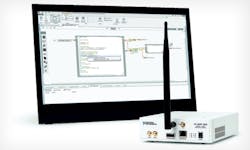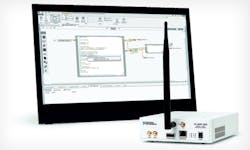Software augments instruments for 5G research
As standards develop and evolve, engineers need flexibility to keep pace as their designs progress and test-equipment requirements change. Software has a key role to play as the standards-development effort leads from models to physical systems. The rollout of 5G technology, discussed in a February article,1 provides a good example of the complementary role for test hardware and design and test software. Recently introduced applicable software products include the SystemVue 5G Baseband Exploration Library from Keysight Technologies and the NI LabVIEW Communications System Design Suite from National Instruments.
Sangkyo Shin, a 5G library product planner and application developer at Keysight, said the 5G Exploration Library combines into the SystemVue platform reference models for 5G waveform development. It includes source code written in C++ for 5G physical-layer research. Customers—including communications system architects, algorithm developers, and standards researchers—can modify the source code and maintain full control of their IP without exposing their own source code.
The library offers several key features:2
- advanced digital signal processing blocks for 5G candidate waveform technologies;
- end-to-end physical-layer transmit and receive simulation models;
- signaling schemes for multiple input and output (MIMO) channels including spatial multiplexing, space-time coding, and multiple detection methods;
- adaptive digital beamforming modeling examples;
- synchronization, channel estimation, and MIMO receiver functions;
- reference waveform generation to verify RF circuit design;
- system-level performance evaluation and BER/FER testing; and
- MIMO modeling blocks.
Shin, who specializes in wireless communications, digital signal processing, physical-layer modeling, and simulation, said, “Customers need to explore different waveforms and compare new proposed technologies, and those are time-consuming tasks.” The reference library saves time and reduces risk. The library’s usefulness extends from research through design simulation and prototype system validation using test-and-measurement instrumentation for signal generation and analysis. The 5G library connects to Keysight’s 4G library so existing customers can compare 4G and 5G technologies and investigate technology convergence, he said.
Roger Nichols, Keysight 5G program manager, added that the licensing scheme the company developed for the 5G Exploration Library provides customers with source code to offer them two significant dimensions of flexibility. “First, we will continue to update and add to this to allow for an expanding array of exploration topics,” he said. “Second, researchers appreciate the ability to change their environments—this is critical to expand the horizons of what they do and to make focused changes in the capability of the software as they try out new ideas.”
In addition to commenting on the 5G Exploration Library, Nichols also cited Keysight’s vector signal analysis software, to which the company continues to add new features. “Some recent examples include the addition of broadband group-delay measurements and impulse-response measurements for assessment of broadband channels (channel sounding).” The company also offers a comprehensive library of signal-generation software, which will create standards-compliant signals when coupled with Keysight’s RF, microwave, and millimeter-wave signal sources. “Since there is no 5G standard, we also have added the capability for flexible OFDM generation,” he said.
Flexibility in instrumentation is critical, too, and Nichols cited the smart-mixing capability of its signal analyzers and multiplier modules for signal sources. “These allow frequency extensions to existing tools for measurements where customers need them,” he said. “We can extend our vector signal analysis capability as far as 1.1 THz.” In addition, he said, Keysight’s modular high-speed digitizers/digital-downconverters can be combined to provide up to 40 phase-coherent channels at a 1.6-GHz sample rate with 12-bit resolution. He concluded, “Our 63-GHz digital oscilloscopes can provide four phase-coherent channels for measurements and analysis of high-speed digital as well as radio frequencies. We have a broad range of test capability that is well-suited for 5G research and for development when that stage comes.”
Flexible hardware and software
National Instruments also is addressing 5G rollout with a flexible hardware and software approach. Charles Schroeder, director of product marketing for RF and wireless communications at NI, said, “At the core of NI’s 5G solutions is the LabVIEW reconfigurable I/O (RIO) architecture, which combines LabVIEW software with reconfigurable off-the-shelf hardware.” Systems are available in two form factors and at several price points, with the hardware sharing a consistent architecture that includes a floating-point processor, an open industry-standard FPGA, and RF signal-analysis and generation capability. “The LabVIEW software and IP ports connect seamlessly across the different hardware targets,” he added.
Courtesy of National Instruments
As 5G solutions, let alone standards, are still in exploration and research,” he said, “no one can describe with certainty how test equipment needs will evolve for 5G. This uncertainty reinforces the need for a flexible test and measurement instrumentation platform such as PXI that allows for changing I/O requirements, higher bandwidths, and new waveform implementations. In contrast, organizations invested in legacy, vendor-defined box instruments incur significant capital costs as they replace fleets of obsoleted instruments with the arrival of each new generation of wireless communication.”
Schroeder added that combining a design environment like LabVIEW and flexible hardware like the NI-USRP (Universal Software Radio Peripheral) or PXI instrumentation can support the prototyping of the next-generation 5G systems. Success at the prototyping stage provides a good indication that these same platforms will be ready to test 5G solutions when they arrive. He added, “The open software architectures of NI’s RF modules, for instance, allow the instruments to rapidly evolve with the emergence of new RF waveforms such as GFDM [generalized frequency division multiplexing] and FBMC [filter bank multicarrier].” Further, he explained, the tight synchronization inherent in the PXI backplane makes PXI suitable for testing evolving MIMO standards, and the modularity of PXI allows engineers to incrementally add new hardware capabilities as needs evolve.
On the software side, NI offers the LabVIEW Communications System Design Suite. “From a test perspective, most traditional test instruments are designed as single-function measurement devices,” Schroeder said. A unique feature of the NI platform, he added, is the open, software-designed nature of the products. “NI customers can see and modify any element of the software and firmware stacks of our RF instruments. Taking advantage of the openness, customers use the instruments to both measure RF characteristics and prototype new communications algorithms. This unprecedented level of openness makes them equally good for RF test and RF algorithm design.”
Facilitating collaboration
“NI is working with leading 5G wireless researchers to provide the fastest path from design to prototype,” Schroeder said. “NI’s approach combines LabVIEW system design software with the software-defined radio platform to help researchers reduce the time from theory to results by testing their designs in a real-world environment.”
He added, “NI customers have identified four key research areas that will have the largest impact on progressing 5G: massive MIMO, new waveforms, dense networks, and millimeter-wave communications.” He cited one customer’s collaborative initiative. By using NI’s integrated hardware and software baseband platform, he said, Nokia plans to expedite its research and rapidly demonstrate the viability of high-frequency millimeter wave technology as an option for 5G radio access.
Schroeder quoted Lauri Oksanen, vice president of research and technology at Nokia, as saying, “Our experimental 5G proof-of-concept system will be implemented using NI’s LabVIEW and PXI baseband modules, which is the state-of-the-art experimental system for rapid prototyping of 5G air interface available today.”
Other test and measurement companies, too, recognize the role of software and the importance of collaboration. According to Bob Kersey, marketing director for wireless test solutions at Anritsu, “As the industry turns its focus to real networks and devices, the major companies work closely with leading test equipment manufacturers, such as Anritsu, to accelerate their time to market.” He noted that developing the test capability ahead of early devices is critical for successful technology rollouts, and such capabilities played a significant role in the early start-up of 3G and 4G services. He added that partnerships may be the only way to resolve the typical paradoxes that result when new technologies push the boundaries of what is possible with current hardware and software.
“Test equipment continues to play a central role as 5G grows toward mass deployment,” Kersey added. “Device problems that escape into the hands of potentially millions of users are difficult and expensive to rectify and in some cases can cause real business damage. Each new technology pushes the scope of testing upwards—not only because of the specific challenges that technology introduces, but also because the number of potential interworking scenarios doubles.”
Andreas Roessler, technology manager at Rohde & Schwarz, said Rohde & Schwarz is involved in several 5G activities and projects worldwide. “The Future Forum in China is one example,” he said, adding that another is “…our participation in the 5G Innovation Centre driven by University of Surrey in the United Kingdom. Rohde & Schwarz also is a sponsor of the 5G Lab spearheaded by the Technical University of Dresden and the well-known industry veteran Prof. Gerhard Fettweis.” In addition, he said, “Rohde & Schwarz contributes to important research projects under the European Union initiative called Horizon 2020. We further support key customers with our test and measurement solutions and testing expertise.”
The work will continue. Nichols at Keysight said that the fundamental measurement capabilities that customers put to use today will be needed for research and further development when systems start to be designed to early standards. “What really makes this feasible is the flexibility we have in our software,” he concluded.
References
- Nelson, R., “Test to play key role in 5G rollout,” EE-Evaluation Engineering, February 2015, p. 12.
- W1906BEL 5G Baseband Exploration Library, Keysight Technologies, Data Sheet, Oct. 10, 2014.
For More Information

